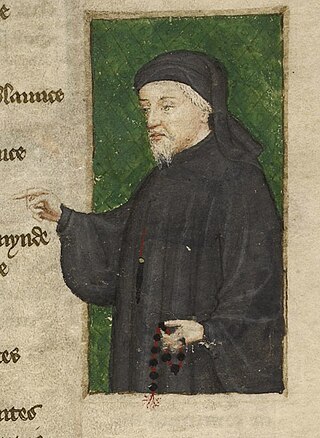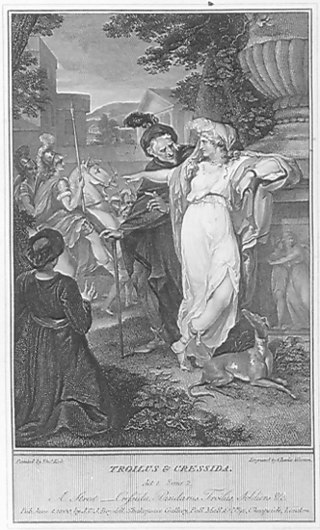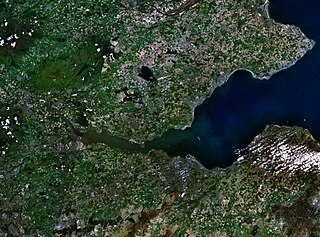Related Research Articles

Geoffrey Chaucer was an English poet, author, and civil servant best known for The Canterbury Tales. He has been called the "father of English literature", or, alternatively, the "father of English poetry". He was the first writer to be buried in what has since come to be called Poets' Corner, in Westminster Abbey. Chaucer also gained fame as a philosopher and astronomer, composing the scientific A Treatise on the Astrolabe for his 10-year-old son, Lewis. He maintained a career in the civil service as a bureaucrat, courtier, diplomat, and member of parliament.

Pandarus or Pandar is a Trojan aristocrat who appears in stories about the Trojan War.

This article focuses on poetry from the United Kingdom written in the English language. The article does not cover poetry from other countries where the English language is spoken, including the Republic of Ireland after December 1922.
Rhyme royal is a rhyming stanza form that was introduced to English poetry by Geoffrey Chaucer. The form enjoyed significant success in the fifteenth century and into the sixteenth century. It has had a more subdued but continuing influence on English verse in more recent centuries.
According to the medieval poet Jean Bodel, the Matter of Rome is the literary cycle of Greek and Roman mythology, together with episodes from the history of classical antiquity, focusing on military heroes like Alexander the Great and Julius Caesar. Bodel's division of literary cycles also included the Matter of France and the Matter of Britain. The Matter of Rome includes the Matter of Troy, consisting of romances and other texts based on the Trojan War and its legacy, including the adventures of Aeneas.

Robert Henryson was a poet who flourished in Scotland in the period c. 1460–1500. Counted among the Scots makars, he lived in the royal burgh of Dunfermline and is a distinctive voice in the Northern Renaissance at a time when the culture was on a cusp between medieval and renaissance sensibilities. Little is known of his life, but evidence suggests that he was a teacher who had training in law and the humanities, that he had a connection with Dunfermline Abbey and that he may also have been associated for a period with Glasgow University. His poetry was composed in Middle Scots at a time when this was the state language. His writing consists mainly of narrative works. His surviving body of work amounts to almost 5000 lines.

Gavin Douglas was a Scottish bishop, makar and translator. Although he had an important political career, he is chiefly remembered for his poetry. His main pioneering achievement was the Eneados, a full and faithful vernacular translation of the Aeneid of Virgil into Scots, and the first successful example of its kind in any Anglic language. Other extant poetry of his includes Palice of Honour, and possibly King Hart.

Flyting or fliting, is a contest consisting of the exchange of insults between two parties, often conducted in verse.

Troilus and Criseyde is an epic poem by Geoffrey Chaucer which re-tells in Middle English the tragic story of the lovers Troilus and Criseyde set against a backdrop of war during the siege of Troy. It was written in rime royale and probably completed during the mid-1380s. Many Chaucer scholars regard it as the poet's finest work. As a finished long poem, it is more self-contained than the better known but ultimately unfinished The Canterbury Tales. This poem is often considered the source of the phrase: "all good things must come to an end" (3.615).

A makar is a term from Scottish literature for a poet or bard, often thought of as a royal court poet.
The term Middle English literature refers to the literature written in the form of the English language known as Middle English, from the late 12th century until the 1470s. During this time the Chancery Standard, a form of London-based English, became widespread and the printing press regularized the language. Between the 1470s and the middle of the following century there was a transition to early Modern English. In literary terms, the characteristics of the literary works written did not change radically until the effects of the Renaissance and Reformed Christianity became more apparent in the reign of King Henry VIII. There are three main categories of Middle English literature, religious, courtly love, and Arthurian, though much of Geoffrey Chaucer's work stands outside these. Among the many religious works are those in the Katherine Group and the writings of Julian of Norwich and Richard Rolle.

The Kingis Quair is a fifteenth-century Early Scots poem attributed to James I of Scotland. It is semi-autobiographical in nature, describing the King's capture by the English in 1406 on his way to France and his subsequent imprisonment by Henry IV of England and his successors, Henry V and Henry VI.

The Testament of Cresseid is a narrative poem of 616 lines in Middle Scots, written by the 15th-century Scottish makar Robert Henryson. It is his best known poem. It imagines a tragic fate for Cressida in the medieval story of Troilus and Criseyde which was left untold in Geoffrey Chaucer's version. Henryson's cogent psychological drama, in which he consciously resists and confronts the routine depiction of Cressida (Cresseid) as simply 'false', is one of the features that has given the poem enduring interest for modern readers and it is one of the most admired works of Northern Renaissance literature. A modern English translation by Seamus Heaney, which also included seven of Henryson's fables from The Morall Fabillis, was published in 2009.
The Eneados is a translation into Middle Scots of Virgil's Latin Aeneid, completed by the poet and clergyman Gavin Douglas in 1513.
Robert Kay Gordon (1887–1973) was an English scholar of medieval and early modern English literature and administrator at the University of Alberta in Canada.
The Floure and the Leafe is an anonymous Middle English allegorical poem in 595 lines of rhyme royal, written around 1470. During the 17th, 18th, and most of the 19th century it was mistakenly believed to be the work of Geoffrey Chaucer, and was generally considered to be one of his finest poems. The name of the author is not known but the poem presents itself as the work of a woman, and some critics are inclined to take this at face value. The poet was certainly well-read, there being a number of echoes of earlier writers in the poem, including Geoffrey Chaucer, John Lydgate, John Gower, Andreas Capellanus, Guillaume de Lorris, Guillaume de Machaut, Jean Froissart, Eustache Deschamps, Christine de Pizan, and the authors of the "Lai du Trot" and the Kingis Quair.

Troy Book is a Middle English poem by John Lydgate relating the history of Troy from its foundation through to the end of the Trojan War. It is in five books, comprising 30,117 lines in ten-syllable couplets. The poem's major source is Guido delle Colonne's Historia destructionis Troiae.

Scottish literature in the Middle Ages is literature written in Scotland, or by Scottish writers, between the departure of the Romans from Britain in the fifth century, until the establishment of the Renaissance in the late fifteenth century and early sixteenth century. It includes literature written in Brythonic, Scottish Gaelic, Scots, French and Latin.

Poetry of Scotland includes all forms of verse written in Brythonic, Latin, Scottish Gaelic, Scots, French, English and Esperanto and any language in which poetry has been written within the boundaries of modern Scotland, or by Scottish people.

Scots-language literature is literature, including poetry, prose and drama, written in the Scots language in its many forms and derivatives. Middle Scots became the dominant language of Scotland in the late Middle Ages. The first surviving major text in Scots literature is John Barbour's Brus (1375). Some ballads may date back to the thirteenth century, but were not recorded until the eighteenth century. In the early fifteenth century Scots historical works included Andrew of Wyntoun's verse Orygynale Cronykil of Scotland and Blind Harry's The Wallace. Much Middle Scots literature was produced by makars, poets with links to the royal court, which included James I, who wrote the extended poem The Kingis Quair. Writers such as William Dunbar, Robert Henryson, Walter Kennedy and Gavin Douglas have been seen as creating a golden age in Scottish poetry. In the late fifteenth century, Scots prose also began to develop as a genre. The first complete surviving work is John Ireland's The Meroure of Wyssdome (1490). There were also prose translations of French books of chivalry that survive from the 1450s. The landmark work in the reign of James IV was Gavin Douglas's version of Virgil's Aeneid.
References
Burrow, J.A. "Henryson: the Preaching of the Swallow." Essays on Medieval Literature.
- Oxford: Clarendon Press, 1984. 148-160.
Fradenburg, Louise O. "The Scottish Chaucer." Writing After Chaucer: Essential
- Readings in Chaucer and the Fifteenth Century. Ed. Daniel J. Pinti. New York:
- Garland, 1998. 167-176.
Goldstein, James R. "Writing in Scotland." The Cambridge History of Medieval English
- Literature. Cambrigdge: Cambridge UP, 1999. 237-254.
Ridley, Florence H. "Middle Scots Writers." A Manual of the Writings in Middle
- English. Ed. Albert E. Hartung. Vol. 4. New Haven: The Connecticut
- Academy of Arts and Sciences, 1973. 961-1060.
Smith, G. Gregory. "The Scottish Chaucerians." The Cambridge History of English and
- American Literature: An Encyclopedia in Eighteen Volumes. Ed. A. W. Ward and
- A. R. Waller. Jan. 2000. Bartleby.Com.14 Mar. 2008. <http://www.bartleby.com/212/1001.html>.
Speirs, John. The Scots Literary Tradition. London: Chatto & Windus, 1940. 3-67.
